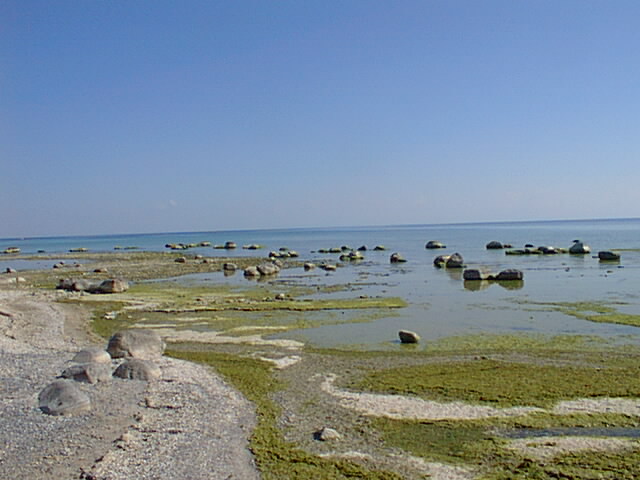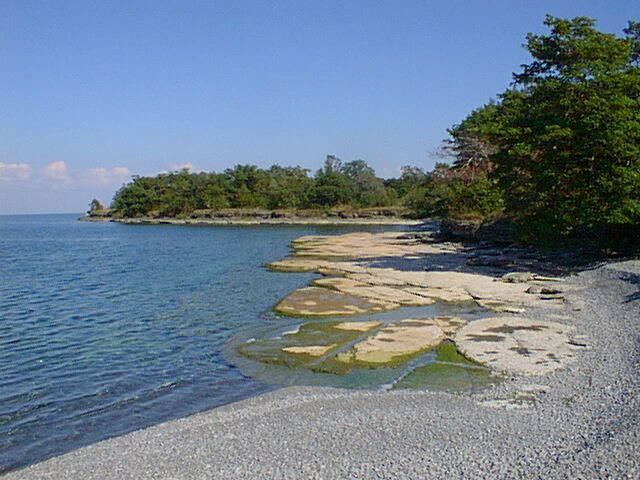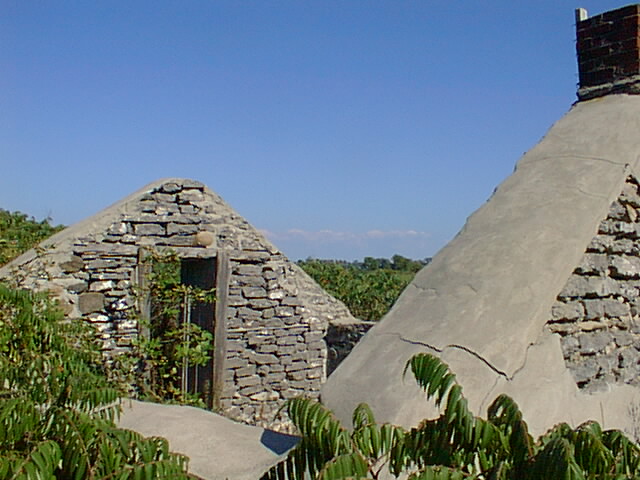Trip to Main Duck Island, 2007
|
Summary: Sailing from Port Credit to Main Duck Island in Lake Ontario aboard "Al Hoceima", our 41' French-built Petit Prince steel ketch. Interesting conditions were encountered that made use of the jacklines, had us heave-to for a few hours, and got us to the destination fairly quickly. You may want to check out our Selected Books section under the Cruising - Handling Heavy Weather category for books covering some of the "interesting" wind/waves conditions mentioned in the article below.
|
Thousand Islands Vacation August 2007.
We had planned a three week trip to take us from Port Credit to Main Duck Island
(about 135 nm), Kingston, the Thousand Islands and back. It was to take us about
38 hours to get to Main Duck and then everything else was a few hours here
and there, save the return trip.
Click to enlarge the route map
Malcolm was working, so he couldn’t take time off. Since we were moving his
home, he found alternate living arrangements with his father. This involved lots
of train travel to and from work.
Dave and I were sailing alone, so someone had to be alert and on deck at all
times. I find being on watch alone at night incredibly boring and count the
minutes until the shift is over. We were doing four hours on and four off and
when I was on shift, Dave tended to stay in the pilot house with me, all covered
up and semi-awake in case I had problems. I don’t think he slept at all.
We sailed all night long and encountered a terrible storm front, which had us
rocking from side to side and front to back. Some of the waves were 15 feet or
more. A trip which would ordinarily take 38 hours, took 28 (even with a four
hour break near the end).
We had ourselves tethered to the boat, couldn’t eat or drink because we were
sick. (The only time I tried to get a glass of water, the boat heaved just as I
opened the cupboard and the dishes went flying on top of me as I hit the floor.
I left everything where it lay and went up top.)
I managed a couple of hours of sleep below during one of Dave’s watches. I’ll
let him explain what happened while I slept:
Dave: I actually really enjoy the night watches (during normal weather!).
There’s no need to stare at the compass continually if it’s a clear night – just
get the boat on the correct heading, pick a star that’s conveniently lined up
with a shroud or mast, and off you go. Just check the compass periodically to
make sure you haven’t accidentally swapped stars, and pick a new star every hour
or so since the heavens rotate above you over time.
I really like the quiet and peacefulness of night sailing, the stars (much
brighter than when in the city!), and glow from distant cities if near enough to
shore.
But the night Angi is describing wasn’t so serene. I believe I had the midnight
to 4 a.m. shift, and while AJ was down below trying to catch some sleep, the
winds and waves built and built.
The barometer was dropping, and from the clouds gathering to the south-west of
us, I had a feeling we were going to encounter some weather.
We were sailing under full press (main, mizzen, Genoa), and making hull speed
constantly, so it was time to shorten sail.
Since we don’t have roller furling, I decided to just drop the Genoa and
continue on main and mizzen alone until the approaching weather presented
itself. It’s a pain to swap sails alone at night, and since we weren’t racing
(we never do), I didn’t mind losing a bit of speed for the sake of convenience
and safety for a short while.
Angi – Dave, please describe the contortions, etc., to actually get the Genoa
down.
Dave – Usually it’s really easy – I like to put the boat on a heading that will
allow the main to blanket the genny, or face right into the wind, so that it
just slides right down onto the deck when the halyard is released. But it was a
bit more interesting that night for a few reasons.
The boat was rising and falling about 10’ every few seconds, the foredeck was
wet, and we were healed over about 15 degrees, and it was completely dark. Plus,
at the time, the wire portion of the halyard was attached to the rope portion
with a thimble and eye, making a lump that got jammed quite solidly where the
lower shrouds attach to the mast. I’ve since spliced the rope to the wire
properly so it won’t get jammed again.
So some crawling on all-fours on the foredeck was required along with a fair bit
of cursing and yanking (the cursing actually helps, I find, to motivate the
stuck part to free itself) to get the halyard unstuck and able to run free
again. Once the genny came down, I didn’t bag it but temporarily lashed it along
the deck to the lifelines on the leeward side in case we needed it after the
front rolled by (we didn’t!).
It was definitely a bit of an effort in those conditions, alone on deck, in the
dark, with the extra encumbrance of being tethered to the boat via jacklines and
safety harness.
I only had to wait about 15 minutes. We wound up sailing for the rest of the
night under main and mizzen only, on a broad reach, before waves, which eventually
built to 4m on average, with winds steadily in the 40 – 50 knot range, still
making a constant hull speed. Not dangerous conditions for Al Hoceima at all (It
wasn’t that way for everyone though - I monitored about 10 separate Mayday calls
during the night, and we heard a number of them the next day – none were in our
vicinity though, so we weren’t involved in helping out), but not comfortable
either, especially with the short, steep waves you get on the Great Lakes.
We were both somewhat seasick since it was our first night out (it usually takes
me 1-3 days to get my sea-legs, and it was only Angi’s second open water trip of
any distance).
We basically continued that way the rest of the night, and when it was time for
Angi’s turn at 4 a.m., we decided to just heave-to and wait for dawn because we
were nearing a position for a planned course change that would put us on a dead,
or near to dead, run. With the size of seas, darkness, and Angi’s being new at
this sailing business, it was just too much to ask of her and too dangerous
should we have an accidental gibe.
So I put us on a starboard tack, dropped the main, hauled the mizzen in hard
amidships, and secured the helm to keep us pointed into the wind. The boat has a
long underwater profile and is perfectly happy hove-to on mizzen, as well as the
more traditional backed-jib method. We then both tried to catch some fitful rest
until morning.
Angi – Dave, why choose a starboard tack to heave-to?
Dave - Being on a starboard tack would make us the “stand on” or “privileged”
vessel in case another sailboat happened across our path – in other words,
approaching sailboats would be required to keep clear of us according to the
‘rules of the road’. Starboard tack means that the wind is striking starboard
side of the boat, and the mainsail would be carried to port.
When morning came, we were still snugly hove-to, and finally got to see the
waves we’d been feeling all night long – pretty impressive for a lake! Still in
the 4m or so range (13-15 feet) with the occasionally larger one, with breaking
but not plunging crests. We were riding over them quite happily, taking them on
the starboard forward quarter.
We then plotted a new course to steer for Main Duck, got under way again, and
had quite a wild downwind ride for the rest of the trip, hand-steering to avoid
broaching and accidental gibes since the conditions were a bit too much for the
autohelm.
We made Main Duck with no difficulties other than fatigue (Angi is correct – I
really didn’t sleep at all for the entire trip) with the winds and waves finally
abating, and tucked in to the lee of the island just to the west of Schoolhouse
Bay.
The total passage time was 28 hours – 10 hours better than my previous best. Not
bad considering Al Hoceima is a heavily built, heavily laden live-aboard cruiser
with very old sails, we were trying to be conservative with the sail area, and
took 4 hours off while hove-to!
Angi: We reached the lee side of Main Duck and anchored. After that storm, it
was amazingly sunny and gentle there.
Angi - Note: Anchoring at Main Duck is an experience. You are basically
anchoring among smooth slabs of rock on the windward side and boulders on the
leeward side unless you are quite a distance from shore. Dave, any comments?
Dave – True – it doesn’t have the best holding ground because of its rockiness;
the better-holding mud bottom starts in fairly deep water on the leeward side (where it’s safest to anchor most of the
time), and even the leeward side can get quite rough in N, NE, NW winds
(prevailing is SW). I’ve anchored on the SW side of the island for the day
before and was lucky enough to land the anchor in a patch of boulders – much of
that side of the island’s lakebed is very smooth granite with no holding
opportunities at all.
The water is shallower on that side, so I actually swam down the 20’ to the
anchor and made sure it was well wedged in. We had a trip line attached to the
back of the anchor to make retrieval easy later, and weren’t planning on
spending the night as it can get quite rough on that side.
The NE side of the island is generally more protected, but outside of
Schoolhouse Bay, the anchoring depths are on the 40' – 60’ range. Schoolhouse Bay
is a terrifically protected spot and even has a small dock, but is very small
and shallow – I managed to squeeze in there in my previous boat, “Belle Argo”,
with an inch or so to spare beneath her 4’6” or so deep keel. The dock is even
shallower.
There is another small bay just to the W of Schoolhouse bay that is good for 2
or 3 boats to fit in to, and is in the 12 to 20’ range for depth. It is just as
exposed to N winds as the rest of that side of the island though, and if your
anchor drags there, you’ve got little time to correct things before winding up
on a rocky shore.
If memory serves, it took a few attempts to get our (slightly light for this
boat, I think) 45 lbs CQR anchor + 230’ of 3/8 BBB chain to hold. We’ve since
added another 200’ of 5/8 nylon double-braid spliced onto the end of the chain.
Angi:
I wasn’t afraid during the trip, just nauseated and tired. Dave said in the
years that he’s been sailing, those were the biggest conditions he has been in,
and so chances are I’ll never experience a storm like that again. Also, I
survived. Yippee.
As we lounged the next day, making up for lack of sleep and food, after cleaning
up the mess below, we listened to
a number of Mayday calls again over the radio – the lake was still a bit rough.
It sounded as though most of them were small open power boats.
Main Duck Island is in the middle of nowhere at the east end of Lake Ontario.
It’s about five hours to Kingston from there in our boat (going an average of 5
knots, with mainsail, mizzen and main jib).
Fishermen and their families began living there in the early 1800s and some
families still lived there during fishing season (and a few hardy souls through
the winter) in the early decades of the 20th century. The Island is now part of
the Parks Canada system and may become a marine ecological sanctuary in future.
The old buildings are still there: a schoolhouse, a tiny stone house and a few
others. You can walk a good part of the island in a couple of hours.
I found Main Duck amazing: Even though it is relatively small – 209 hectares or
518 acres - it has different climate zones. The water is clear, the shoreline,
lovely; close to the windward shore there is what feels like a mini-rainforest, humid and
over-grown and then there is a large arid savannah-like area in the interior.
 Windward Side of Main Duck |
 Leeward Side of Main Duck |
 Beach made of Zebra Mussels! |
 Settler's Cabin on Main Duck |
Main Duck Grasslands and Anchorage |
Click to visit Parks Canada's
St. Lawrence Islands National Park page.
© Copyright 2008
David S. Malar and Angelika Jardine. All rights reserved.
Home -
www.selfmadesailor.com
Website Design and SEO (Search Engine Optimization) by VentureIT.ca